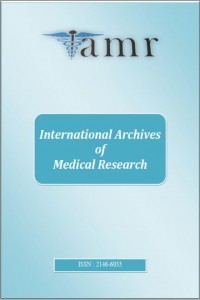Adolescents with Migraine Experience More Daytime Dysfunction than Other Counterparts: A Descriptive Cross-Sectional Study
Adolescents with Migraine Experience More Daytime Dysfunction than Other Counterparts: A Descriptive Cross-Sectional Study
migraine, BRIAN, QoL, sleep, adolescent,
___
- 1. Lehmann S, Milde-Busch A, Straube A, von Kries R, Heinen F. How specific are risk factors for headache in adolescents? Results from a cross-sectional study in Germany. Neuropediatrics. 2013; 44(1):46-54. doi: 10.1055/s-0032-1333432.
- 2. Headache Classification Committee of the International Headache Society (HIS). The International Classification of Headache Disorders. 3rd edition (beta version). Cephalalgia. 2013; 33(9):629-808.
- 3. American Psychiatric Association (APA). Diagnostical and Statistical Manual of Psychiatric Disorders, Fifth Edition, Washington DC., 2013.
- 4. Saglam M, Arikan H, Savci S, Inal-Ince D, Bosnak-Guclu M, Karabulut E, Tokgozlu L. International physical activity questionnaire: reliability and validity of the Turkish version. Percept Mot Skills 2010; 111(1):278-284.
- 5. Eser E, Fidaner H, Fidaner C, Eser SY, Elbi H, Göker E. Psychometric properties of the WHOQOL-100 and WHOQOLBREF. J Psychiatry Psychol Psychopharmacol 1999; 7(2): 23-40.
- 6. Giglio LM, Magalhaes PV, Andreazza AC, Walz JC, Jakobson L, Rucci P et al. Development and use of a biological rhythm interview. J Affect Disord 2009; 118:161-165.
- 7. Aydemir O, Akkaya C, Altınbaş K, Kora K, Sücüllüoğlu D, Akdeniz F, Kalaycı F, Oral ET, Vahip S. Reliability and validity of Turkish version of Biological Rhythms Interview of Assessment in Neuropsychiatry. Anatolian Journal of Psychiatry 2012; 13:256-261.
- 8. Buysse DJ, Reynolds CF, Monk TH. The Pittsburgh Sleep Quality Index: a new instrument for psychiatric practice and research. Psychiatry Res 1989; 28:193- 213.
- 9. Agargun MY, Kara H, Anlar O. Pittsburgh Uyku Kalitesi İndeksi’nin Geçerliği ve Güvenirliği. Turk Psikiyatri Derg 1996; 7:107-11. [In Turkish]
- 10. Bruni O, Russo PM, Ferri R, Novelli L, Galli F, Guidetti V. Relationships between headache and sleep in a non-clinical population of children and adolescents. Sleep Med. 2008; 9(5):542-548.
- ISSN: 2146-6033
- Yayın Aralığı: Yılda 2 Sayı
- Başlangıç: 2011
- Yayıncı: Veysi AKPOLAT
Betül BÖRKÜ UYSAL, Derya ARGUN
Intrauterine Testiscular Torsion: A Case Report
Hakan ONUR, Murat Kemal ÇİĞDEM, Müsemma KARABEL
Zeynep GÖKER, Rukiye ÇOLAK, Rezzan AYDIN GÖRÜCÜ, Ayşe Nihal ERASLAN, Özge BALCI, Arzu YILMAZ
Restoration of Anterior Tooth Fractures Using Silicone Key Method: 3 Case Report
Sema YAZICI AKBIYIK, Dilan AYLUÇTARHAN, Elif Pınar BAKIR, Şeyhmus BAKIR
Survival Analysis and Causes of Death of Patients with Lupus Nephritis
Mehmet Ali BALCI, Enver YÜKSEL
Clinical and Trichoscopic Characteristics in a Case of Congenital Triangular Alopecia
Ebru ÇELİK, Deniz DUMAN, Cigdem DOGRAMACİ
The Effect of Dimethyl Sulfoxide on Chromosomal Abnormalities in Human Peripheral Blood Lymphocytes
İlyas YÜCEL, Mahir BİNİCİ, Fikriye Fulya KAVAK, Diclehan ORAL, Selahattin TEKEŞ, Mahmut BALKAN
